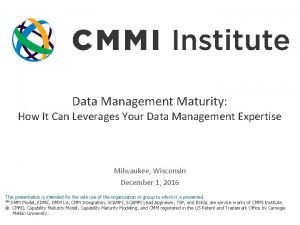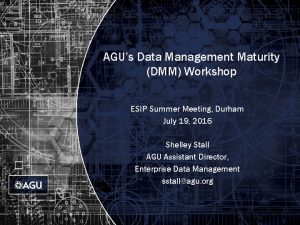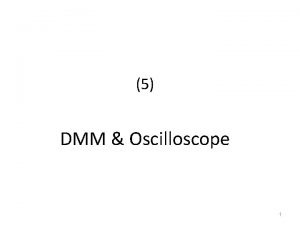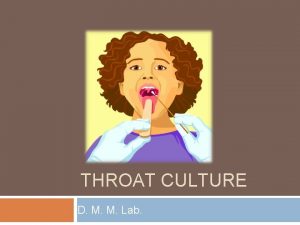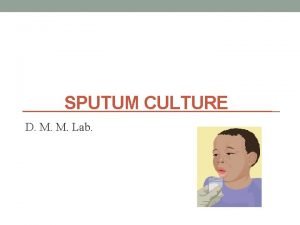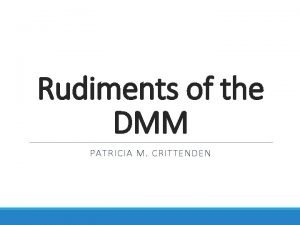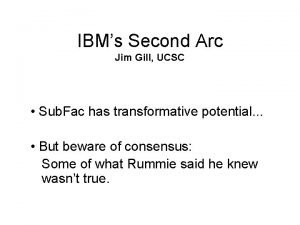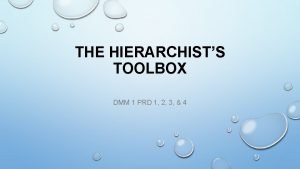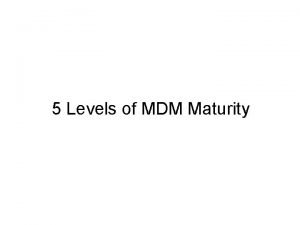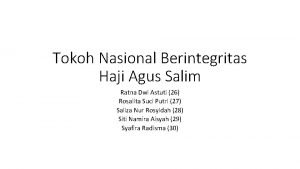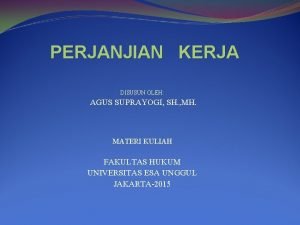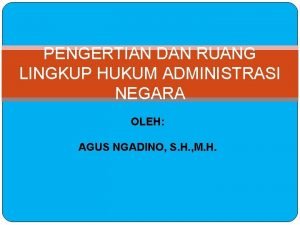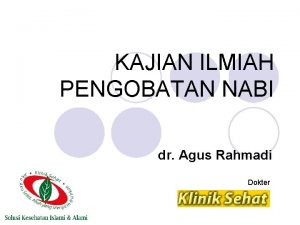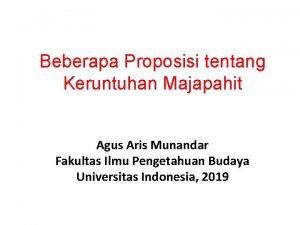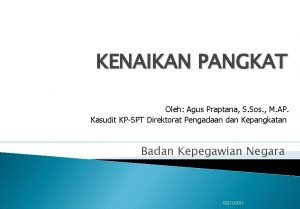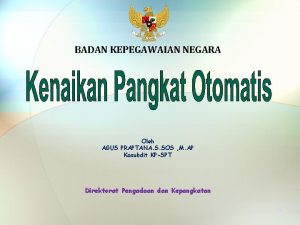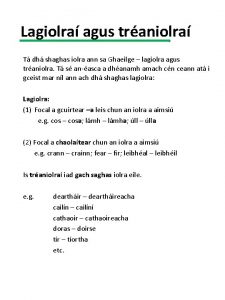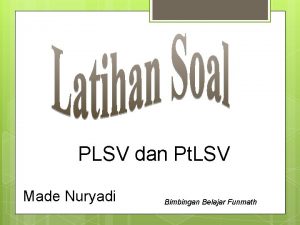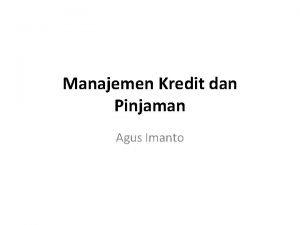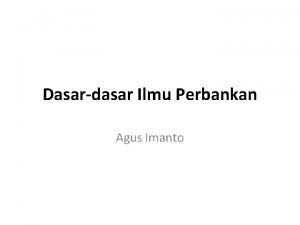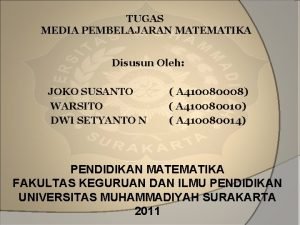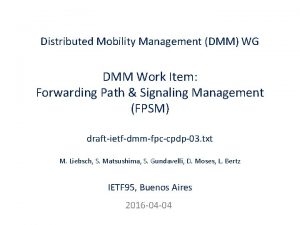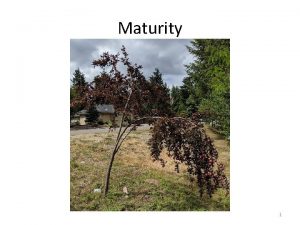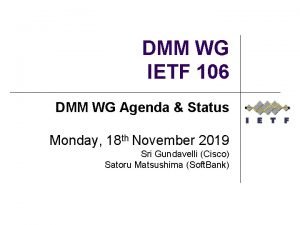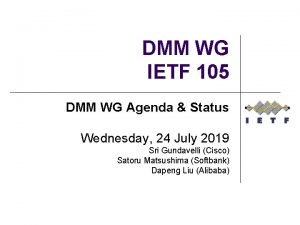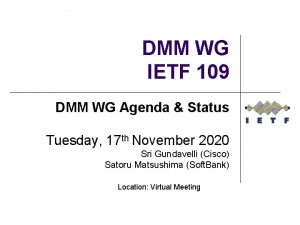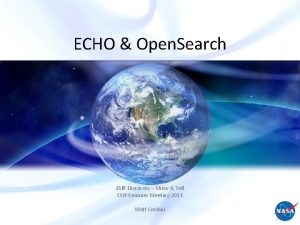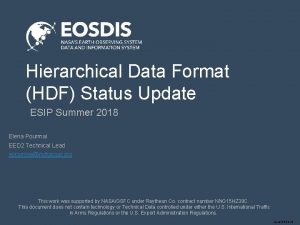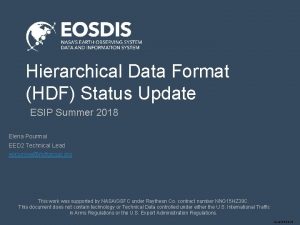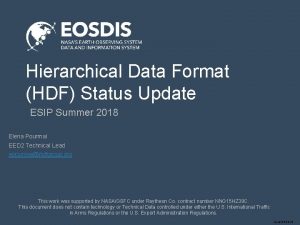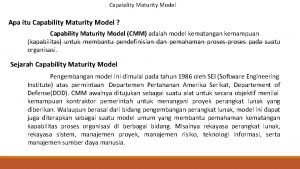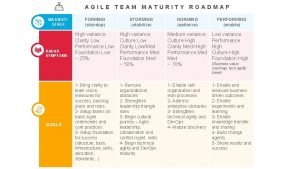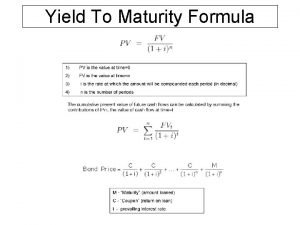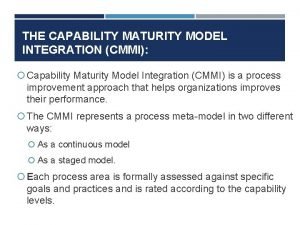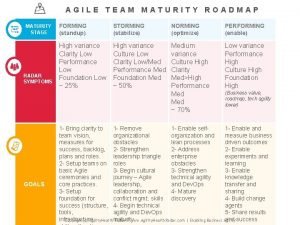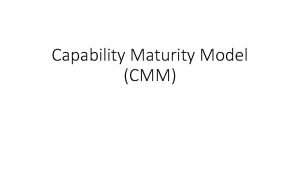AGUs Data Management Maturity DMM Workshop ESIP Summer


























- Slides: 26

AGU’s Data Management Maturity (DMM) Workshop ESIP Summer Meeting, Durham July 19, 2016 Shelley Stall AGU Assistant Director, Enterprise Data Management sstall@agu. org

AGU’s position statement on data affirms that “Earth and space sciences data are a world heritage. Properly documented, credited, and preserved, they will help future scientists understand the Earth, planetary, and heliophysics systems. ” https: //sciencepolicy. agu. org/files/2013/07/AGU-Data-Position-Statement-Final-2015. pdf 2

Data Management Challenges 3

Best Practices for Data Management 3. 5 Years of Development 70 Peer Reviewers ------25 Process Areas 350+ Practice Statements 4

Data Management Maturity (DMM) The DMM is a process improvement and capability maturity model for the management of an organization’s data assets and corresponding activities. It contains best practices for establishing, building, sustaining, and optimizing effective data management across the data lifecycle, from creation through curation, delivery, maintenance, and preservation.

DMMSM Structure 6

DMM – Capability and Maturity • Capability – “We can do this” • Specific Practices – “We’re doing it well” • Work Products – “We’ve documented the processes we are following” (work products, templates, guidelines, standards, etc. ) • Maturity – “…. and we can prove it” • Process Stability – “Solid as a rock” • Ensures Repeatability – “Sustainable Process” • Policy • Training • Resources and Responsibility, etc. 7

DMM Capability Levels Level 5 Optimized Level 4 Measured Level 3 Defined Level 1 2 Managed Performed 8

DMM Capability Levels DM processes are regularly improved and optimized based on changing organizational goals – we are seen as leaders in the DM space DM practices are managed and governed through quantitative measures of process performance DM practices are aligned with strategic organizational goals and standardized across all areas (1) Performed (4) Measured (3) Defined (2) Managed (5) Optimized Target DM practices are deliberate, documented and performed consistently at the program level Data management practices informal and ad hoc Dependent on heroic efforts

DMM Process Area Construct 10

DMM Best Practices Data Requirements Data Quality Strategy Metadata Management Vocabulary/Glossary Data Management Strategy Grant Strategy/Business Case Funding Data Lifecycle Management Communications Data Management Function Data Profiling & Assessment Data Cleansing Curation Contribution Management Governance Management Data Integration Interoperability Architectural Approach Metadata Standards Open Linked Data Citation Data Management Platform Data Archive & Preservation Disaster Recovery Measurement & Analysis Process Management Process Quality Assurance Risk Management Configuration Management

Data Management Strategy Process Areas: Encompasses process areas designed to focus on development, strengthening, and enhancement of the overall data management program. • Data Management Strategy – Defines the vision, goals, and objectives for the data management program and ensures that relevant stakeholders are aligned on program priorities, implementation and management. • Communications – Ensures that policies, progress announcements, and other data management communications are published, enacted, understood, and adjusted based on feedback. • Data Management Function – Provides guidance for data management leadership and staff to ensure that data is managed as an asset. • Grant Strategy/Business Case – Provides a rational for determining which data management initiatives should be funded, and ensures that sustainability of data management by making decisions based on resource considerations and benefits to the organization. • Funding – Ensures the availability of adequate and sustainable financing to support the data management program. 12

Data Governance Process Areas: Identifies important data assets, defines and implements processes to manage the assets, and formally manages them throughout the organization. • Governance Management – Develops the ownership, stewardship, and operational structure needed to ensure that data is managed as a critical asset and implemented to an effective and sustainable manner. • Vocabulary/Glossary – Supports a common understanding of terms and definitions about structured and unstructured data supporting the community for all stakeholders. • Metadata Management – Establishes the processes and infrastructure for specifying and extending clear and organized information about the structured and unstructured data assets under management, fostering and supporting data sharing [to include data discoverability, data understandability, data interoperability], ensuring compliant use of data, improving responsiveness to community changes, and reducing data-related risks. 13

Data Quality Process Areas: Defines a collaborative approach for receiving, assessing, cleansing, and curating data to ensure fitness for intended use in the scientific community. This includes ensuring metadata content and standards are met, data submissions are complete, and data is accessible at the right time. • Data Quality Strategy – Defines an integrated, organization-wide strategy to achieve and maintain the level of data quality required to support the organization’s goals and objectives. Where data quality guidelines are defined at a domain or community level, the strategy incorporates that compliance. • Data Profiling – Develops an understanding of the content, quality, and rules of a specified set of data under management. – This is the first step taken when a new data set is being reviewed. It provides a basic quantitative understanding. For example, profiling can provide the following information: establishing types or number of distinct values in a column, number or percent of zero, blank or null values, string length, date ranges, and data patterns. • Data Quality Assessment – Provides a systematic approach to measure and evaluate data quality according to processes, techniques, and against data quality rules. • Data Cleansing and Curation – Defines the mechanisms, rules, processes, and methods to validate and correct data (and metadata) as appropriate. 14

Data Operations Process Areas: Ensures data requirements are fully specified and data is traceable with documented provenance, manages data changes, and manages data contributions. • Data Requirements Definition – Ensures the data submitted and accessed by the scientific community will satisfy organizational objectives, is understood by all relevant stakeholders, and is consistent with the processes that receive, curate and make data discoverable and accessible. • Data Lifecycle Management – Ensures that the organization understands, maps, inventories, and controls its data flows through processes throughout the data lifecycle from creation or acquisition to curation, archive, preservation and access. • Contribution / Provider Management – Optimizes internal and external contribution of data to satisfy organizational requirements and to manage data access agreements consistently. 15

Platform & Architecture Ensures the implemented data management platform successfully integrates, archives, preserves data assets to support the organization and/or scientific community objectives. • Architectural Approach – Designs and implements an optimal data layer that enables the acquisition, curation, storage, archive, preservation, and access of data to meet organizational and technical objectives. • Architectural Standards – Provides an approved set of expectations for governing architectural elements supporting approved data representations, data access, and data distribution, fundamental to data asset control and the efficient use and exchange of information. • Data Management Platform – Ensures that an effective platform is implemented and managed to meet organizational needs. • Data Integration – Reduce the need for the organization to obtain data from multiple sources, and to improve data availability for organizational processes that require date consideration and aggregation, such as analytics. • Data Archiving and Preservation – Ensures that data maintenance will satisfy organizational and federal requirements for scientific research data availability, and that legal and regulatory requirements for data archiving, preservation and disaster recovery of data are met. 16

Supporting Processes Foundational processes that support adoption, execution, sustainment, and improvement of data management processes. • Measurement and Analysis – Develop and sustain a measurement capability and analytical techniques to support managing and improving data management activities. • Process Management – Establish and maintain a usable set of organizational process assets, and plan, implement, and deploy organizational process improvements informed by the business goals and objectives and the current gaps in the organization’s processes. • Process Quality Assurance – Provide staff and management with objective insight into process execution and the associated work products. • Risk Management – Identify and analyze potential problems in order to to take appropriate action to ensure objectives can be achieved. • Configuration Management – Establish and maintain the integrity of the operational environment using configuration identification, control, status accounting, and audits. 17

Key Notes on DMM Model Construct • The categories presented are not intended to be sequential. They were developed for to organize the Process Area’s into related groups. • The sequence of Process Area’s (PAs) within a Category is not intended to be sequential. The collection of PAs within a Category are for Maturity rating of the Category • Capabilities are guided/assessed based on the collection of Practice Statements listed for each level within the PA (i. e. all Statements listed for levels 1, 2, and 3 to achieve a Level 3 capability within anyone PA). • Statements within any one level of a PA are not intended to be sequential. For example statements 3. 1 and 3. 2 are numbered for reference only (identifies 1 st and 2 statements of level 3) • The specific PAs of focus and sequence of implementation are unique for each organization based on their individual state of activities and organizational objectives. 18

Characterization of Practices Not Yet Implemented Improvements in Progress Partially Implemented Largely Implemented Fully Implemented 19

DMM Maturity – Consistent and Sustainable • Establish an Organizational Policy • Plan the Process • Provide Resources • Assign Responsibility • Train People • Manage Configuration • Identify and Involve Relevant Stakeholders • Monitor and Control the Process • Objectively Evaluate Adherence • Review Status with Senior Management • Establish Standards • Provide Assets that Support the Use of the Standard Process • Plan and Monitor the Process Using a Defined Process • Collect Process-Related Experiences to Support Future Use (re: Use Cases) Applies Across the Organization and to all the Process Areas 20

Assessment - Objective Measurement A Data Management Assessment… Establishes a baseline of capability and maturity. Is conducted by a trained and certified Enterprise Data Management Expert (EDME) to ensure consistency of the method across assessments. Uses an evaluation process for capability and maturity proven over 20 years by over 10, 000 organizations. 21

AGU Data Management Assessment Tools • Data Management Maturity (DMM) process model • Assessment and Scoring Methodology Scope • Organizational processes in place that manage data assets. Objective • Determine level of awareness of best practices and to what extent they are performed. • Characterize the level into capability and maturity. 22

DMM Assessments • The DMM is applied through an assessment. • Assessments include facilitated workshops at the customer facility. • Data management process areas are assessed using granular practice statements as criteria. • Objectives of the organization are used to customize the assessment focus. • Workshops provide education to the organization. • Interviews with key decision makers and influencers are conducted.

DMM Assessment Method Preparation, 2+ weeks Assessment, 3 -5 days Conclusions, 2+ weeks Scope Determination Review of DMM Process Areas Recruit Participants Logistics Onsite Kickoff Workshops Document Review Wrap-Up Briefing Review Findings and Observations Interviews (5 -10) Formulate Recommendations Develop Final Report (Confidential) Executive Briefing 24

AGU Data Management Program: http: //dataservices. agu. org/dmm/ 25

Contact Information: Shelley Stall sstall@agu. org AGU Data Management Program: http: //dataservices. agu. org/dmm/ 26
 Cmmi dmm
Cmmi dmm Data maturity workshop
Data maturity workshop Maturity indices of fruits
Maturity indices of fruits Difference between dmm and oscilloscope
Difference between dmm and oscilloscope Dmm lab
Dmm lab [email protected]
[email protected] Dmm@dmca
Dmm@dmca Izu subs
Izu subs Dmm
Dmm Dmm psychology
Dmm psychology Mdm maturity model
Mdm maturity model Nilai integritas h agus salim
Nilai integritas h agus salim Agus suprayogi
Agus suprayogi Ruang lingkup hukum administrasi daerah
Ruang lingkup hukum administrasi daerah Mo theach agus mo cheantar
Mo theach agus mo cheantar Dr agus rahmadi
Dr agus rahmadi Agus aris munandar
Agus aris munandar Agus praptana bkn
Agus praptana bkn Fionn agus an fathach
Fionn agus an fathach Agus praptana bkn
Agus praptana bkn Agus syihabudin
Agus syihabudin Lagiolra
Lagiolra Umur pak agus 3 kali umur iwan
Umur pak agus 3 kali umur iwan Agus imanto
Agus imanto Agus imanto
Agus imanto In ainm an athar
In ainm an athar Umur pak agus 3 kali umur iwan
Umur pak agus 3 kali umur iwan
